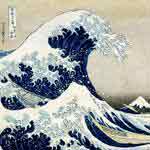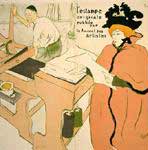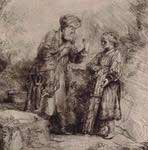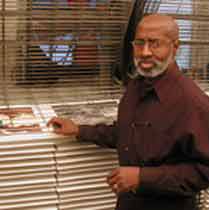And learn from a master printer, Lou Stovall in Washington.
VOICE ONE:
I’m Steve Ember.
VOICE TWO:

And I'm Barbara Klein with EXPLORATIONS in VOA Special English. At the National Gallery of Art in Washington, D.C., you can see a colorful and expressive print called "Revolt on the Amistad." The small sign next to the work says the artist’s name is Jacob Lawrence.
And he did design the image. But who made the print? Today, we answer that question as we explore the world of printmaking. Then, we visit the expert printmaker who made this work of art.
(MUSIC)
VOICE ONE:
To make a print, an artist creates an original image with a form made of wood, metal or plastic. The artist reproduces prints of this original image using liquid colors and paper. There are many methods of printmaking. Often prints are numbered to show how many were made in the edition or series.
The oldest form of printmaking is the woodcut. Woodcut prints may have been used in the Middle East as early as the 15th century to make cloth designs. They were also used starting around the 9th century in China to print documents.
VOICE TWO:
As you might have guessed, woodcut prints are made out of wood. The printmaker first draws an image onto a smooth piece of wood. Then he or she cuts away pieces from the surface.
When the wood has been cut, liquid color called ink is painted onto the surface. It is then pressed on a piece of paper. The areas the printmaker cut away will be lower on the surface of the wood. These parts do not get any ink. But the raised part of the wood does receive the color. A different piece of cut wood is used for every color in the final image. This is called an indirect method because the ink is put on the cut form before it goes on the paper.
VOICE ONE:

This method of printmaking became popular in Europe in the 16th century. Woodcuts were also a widely used artistic form in Japan from the 17th to the 19th century. Japanese prints from this period were called ukiyo-e, or "pictures of the floating world."
Many of these images showed natural scenes of the Japanese countryside. Others showed pictures of city life including popular actors, fat sumo wrestlers, and beautiful women. These prints were popular with the middle class people living in towns. Because the prints were mass-produced and not original works, they were not costly. People could own artwork for a reasonable price.
These ukiyo-e prints had a great influence on many artists in Europe during the 19th century. Painters like Edgar Degas and Vincent Van Gogh used the sharp lines and off-centered look of these prints in their paintings.
(MUSIC)
VOICE TWO:
Lithography is another form of printing. Lithos comes from the Greek word for stone. The artist draws an image with oily ink onto a piece of stone or other flat surface. Next, the stone is covered with a chemical mixture. This chemical will fix the painted image onto the stone. When printing begins, the stone is kept wet and then covered with oily ink. The area where the original image was drawn will then attract the oily printer’s ink. But the blank areas will reject the ink and will instead attract water. This method works because oil and water do not mix.
VOICE ONE:
The lithographic process was invented in the late 18th century by the German writer Aloys Senefelder. Mr. Senefelder wanted to find a low-cost way to reproduce his plays. But he soon realized the artistic possibilities of his lithographic printing method.

French artists in the 19th century became very interested in using lithography. For example, the French artists Honore Daumier and later Henri Toulouse Lautrec were masters of this process. They would draw directly on the stone and a printmaker would do the rest of the work. Lithography is used commercially as well. Picture books, newspapers and packaging all over the world are printed using this process.
VOICE TWO:
Etching is yet another printing process. With this method, the printmaker cuts or etches an image into a piece of metal. The artist uses a fine sharp knife to cut through the metal. This metal form is chemically treated before being covered with ink and then pressed onto paper.

Some artists like this process because they can draw on the metal as easily as if they were using a writing pen. Experts say the greatest artist ever to use this method was Rembrandt. This Dutch artist lived in the 17th century. The detailed perfection of his etchings of nature and religious stories is extraordinary.
VOICE ONE:
Finally, we come to a more modern form of printmaking called silkscreen printing. This method is based on the stencil. A stencil is a thin sheet of metal or plastic out of which a design has been cut.
With silkscreen printing, a stencil is attached to a fine piece of stretched silk or nylon cloth. Under the cloth and stencil is a piece of paper. Liquid paint is passed over the cloth and stencil. The paint goes through the open areas of the stencil cut out onto the paper. For every color in the print, the printmaker makes a different stencil. Of all the printing forms we have described, silkscreen is the only direct method. This means the ink goes directly onto the paper.
Andy Warhol was one artist who made silkscreen prints famous in the 1960s. He made prints with subjects like movie stars and soup cans.
(MUSIC)
VOICE TWO:

The Workshop is on a quiet tree-filled street in Washington, D.C. This is where well-known master printmaker Lou Stovall makes his art. Let us go back to the "Revolt on the Amistad" print we told you about at the beginning of this story.
LOU STOVALL: “The artist is Jacob Lawrence and the silkscreen print maker is myself, Lou Stovall. The image depicts the revolt on the Spanish slave ship “La Amistad”, the action of the fight...you see the swaying ropes, the roiling water. It gives you a real sense of a fight, the drama that’s involved. And that’s one of the things Jacob was noted for. His level of expression is so profound that with even a few strokes, he can pick up the action and show it to you”.
VOICE ONE:
Lou Stovall makes prints for many artists. They come to him with an original image they have created. Then, Stovall uses his artistic skills to translate that work into a print version. It is important that he remain true to the spirit of the original work. He makes very careful decisions about color, shape and line so that he can make the best print possible. Some of his silkscreen prints are so detailed it is hard to believe they are not paintings.
VOICE TWO:
Lou Stovall’s studio is large and very organized. The walls are covered with prints, signs and photographs. One whole wall contains his music collection. A large silkscreen table sits in another area of the room.
Nearby, many shelf surfaces hold recently made prints so that they can dry before other colors are added. Stovall has been working in this studio for more than 30 years. He has taught the silkscreen method to many other artists.
VOICE ONE:
Lou Stovall also makes his own artwork here. Sometimes he makes detailed drawings of flowers and nature. He says he likes the cleanliness of ink drawing on paper. He often makes his drawn images into a series of prints. One of his prints is called “For Ascending Larks.” It is a circular image with many layers of flying birds. His idea for the original drawing came from a piece of music by the English composer Ralph Vaughn-Williams. Listen as Lou Stovall tells about this music and the meaning of his picture.
LOU STOVALL: "The name of the work was ‘The Lark Ascending,’ which I thought was probably one of the most beautiful pieces of music I had ever heard. It inspired me to make a drawing which was a flock of varied birds which represented mankind and humanity. So, it's every shape, size color description of bird that I could think of. I think there are roughly twelve birds in the entire image. I dedicated it to the hunger movement so that we would recognize world hunger and try to do something about it."
VOICE TWO:
Not all of Lou Stovall's art shows recognizable subjects. Some prints look like layers of colorful spills of paint. These "monoprints" are not planned out in the same way as his other works. He says it is exciting to make this kind of expressive print.
VOICE ONE:
Lou Stovall’s prints and artwork can be found in museums and private collections all over America. Some of his art is sold in galleries. Other times, collectors buy his art directly from him. But Lou Stovall says money is not the main reason he makes art. He says there is a magic that happens when creating art. And he says the most important reason artists make their work is to share it with the world.
(MUSIC)
VOICE TWO:
This program was written and produced by Dana Demange. I’m Barbara Klein.
VOICE ONE:
And I’m Steve Ember. You can read and listen to this program on our Web site, voaspecialenglish.com. Join us again next week for Explorations in VOA Special English.
printmaking:印刷术
sumo: a competitive contact sport where two wrestlers attempt to force one another out of a circular ring or to touch the ground with anything other than the soles of the feet 相扑
lithography: a method for printing on a smooth surface. It can be used to print text or artwork onto paper or another suitable material 平版印刷术
stencil: a template used to draw or paint identical letters, symbols, shapes, or patterns every time it is used 模具,印刷模板
Related stories:
ArtBabble shows viewers the world of museums
特拉法广场上的流动艺术
Painter takes art therapy to young people in Uganda
Turner Exhibition Opens at National Art Museum of China
(Source: VOA 英语点津编辑)